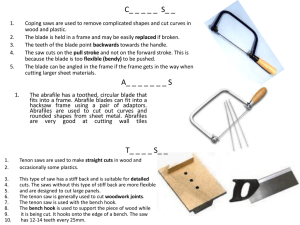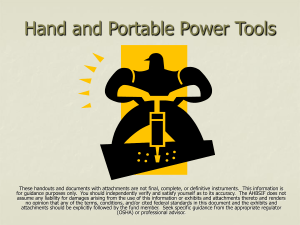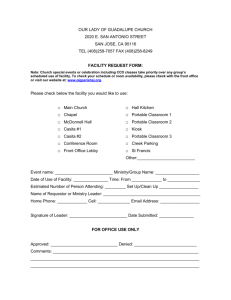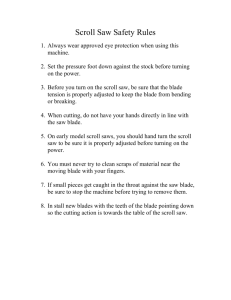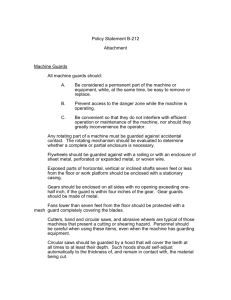Chapter 12 – HAND TOOL AND PORTABLE POWER TOOLS
advertisement
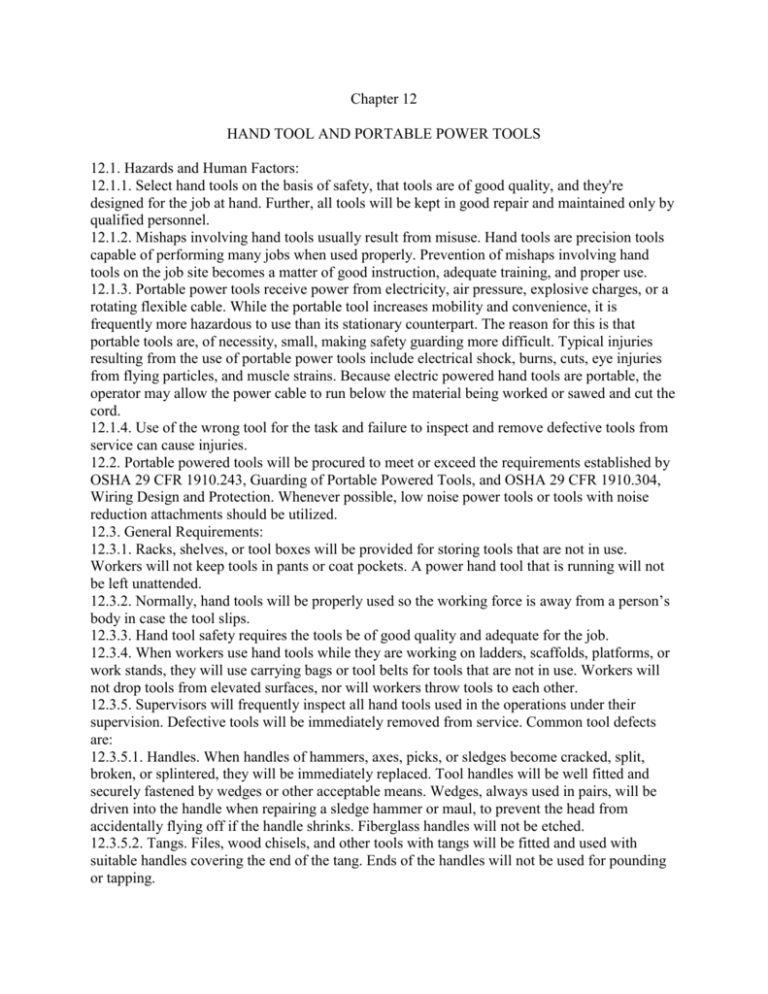
Chapter 12 HAND TOOL AND PORTABLE POWER TOOLS 12.1. Hazards and Human Factors: 12.1.1. Select hand tools on the basis of safety, that tools are of good quality, and they're designed for the job at hand. Further, all tools will be kept in good repair and maintained only by qualified personnel. 12.1.2. Mishaps involving hand tools usually result from misuse. Hand tools are precision tools capable of performing many jobs when used properly. Prevention of mishaps involving hand tools on the job site becomes a matter of good instruction, adequate training, and proper use. 12.1.3. Portable power tools receive power from electricity, air pressure, explosive charges, or a rotating flexible cable. While the portable tool increases mobility and convenience, it is frequently more hazardous to use than its stationary counterpart. The reason for this is that portable tools are, of necessity, small, making safety guarding more difficult. Typical injuries resulting from the use of portable power tools include electrical shock, burns, cuts, eye injuries from flying particles, and muscle strains. Because electric powered hand tools are portable, the operator may allow the power cable to run below the material being worked or sawed and cut the cord. 12.1.4. Use of the wrong tool for the task and failure to inspect and remove defective tools from service can cause injuries. 12.2. Portable powered tools will be procured to meet or exceed the requirements established by OSHA 29 CFR 1910.243, Guarding of Portable Powered Tools, and OSHA 29 CFR 1910.304, Wiring Design and Protection. Whenever possible, low noise power tools or tools with noise reduction attachments should be utilized. 12.3. General Requirements: 12.3.1. Racks, shelves, or tool boxes will be provided for storing tools that are not in use. Workers will not keep tools in pants or coat pockets. A power hand tool that is running will not be left unattended. 12.3.2. Normally, hand tools will be properly used so the working force is away from a person’s body in case the tool slips. 12.3.3. Hand tool safety requires the tools be of good quality and adequate for the job. 12.3.4. When workers use hand tools while they are working on ladders, scaffolds, platforms, or work stands, they will use carrying bags or tool belts for tools that are not in use. Workers will not drop tools from elevated surfaces, nor will workers throw tools to each other. 12.3.5. Supervisors will frequently inspect all hand tools used in the operations under their supervision. Defective tools will be immediately removed from service. Common tool defects are: 12.3.5.1. Handles. When handles of hammers, axes, picks, or sledges become cracked, split, broken, or splintered, they will be immediately replaced. Tool handles will be well fitted and securely fastened by wedges or other acceptable means. Wedges, always used in pairs, will be driven into the handle when repairing a sledge hammer or maul, to prevent the head from accidentally flying off if the handle shrinks. Fiberglass handles will not be etched. 12.3.5.2. Tangs. Files, wood chisels, and other tools with tangs will be fitted and used with suitable handles covering the end of the tang. Ends of the handles will not be used for pounding or tapping. 12.3.6. When dressing tools, a slight bevel of about three-sixteenths of an inch will be ground around the head. This will help prevent the heads from mushrooming. 12.4. Nonpowered Hand Tools. Information on the proper usage of specific tools follows: 12.4.1. Screwdrivers: 12.4.1.1. Standard, straight blade screwdrivers will be maintained with their working edges square and free from chipped areas. If it is not possible to regrind a working edge, the screwdriver will be replaced. Screwdrivers with cracked or loose handles should be turned in for repair or replacement. Screwdrivers are not to be used as a prying tool, punch, wedge, chisel, pinch bar, nail puller, or be struck with a hammer. Workers will ensure they select a screwdriver tip that matches the screw slot. Standard type screwdrivers will not be used on Phillips or crosshead type screw slots. Phillips or crosscut screwdrivers will be used in the correct size relative to the fastener. If the tips of any screwdriver or special fastener are worn or misshaped they will be turned in for a replacement issue. 12.4.1.2. Small objects will not be held by hand, under the arm, or on the lap when being worked on with a screwdriver. Small work will be secured to a flat surface or held in a vise. 12.4.1.3. Workers will ensure they are well braced before applying force to a screwdriver. Firm footing is particularly necessary when using a screwdriver on a ladder or stand where loss of balance could result in a fall. 12.4.2. Chisels. Chisels will be kept sharp with the edge ground true. Cold chisels and punches with mushroom heads will not be used. A chisel or punch holding device will be used when working space permits. The angle of cut will be away from the body. Goggles will be worn when using a chisel, punch, a tapered or straight file, or an alignment drift. 12.4.3. Wrenches. Damaged, bent or broken wrenches, or wrenches with sprung jaws will not be used. Wrenches should not be struck with a hammer unless the wrench is designed for this purpose. Worn box wrenches or sockets will be exchanged for new tools. When excessive pressure is required to free a nut or cap-screw, the pressure should be applied away from the face and body. Care should be taken to avoid being in a position where the hand will strike any part of the object should the wrench slip or the “fastener break." 12.4.3.1. Workers using open-end wrenches will: 12.4.3.1.1. Ensure the wrench fits the nut or bolt head. 12.4.3.1.2. Ensure when attempting to loosen a tight nut or tighten a loose nut, that the wrench seats squarely on the sides of the nut. 12.4.3.1.3. Always PULL on a wrench—not push on it. There may be situations in which pushing is the only way you can work the wrench. In these situations use the base of the palm to push keeping an open hand. On adjustable wrenches always place the wrench on the nut so the pulling force is applied to the stationary jaw side of the handle. 12.4.3.1.4. Where possible, use box wrenches for torque and less chance of slipping off the nut or bolt. 12.4.3.2. Pipe wrenches will have sharp jaws to prevent slippage. Using too small a wrench will cause the jaws to crack or break. 12.4.4. Hammers. Hammers vary in hardness and are designed for specific uses. A hammer of suitable size and weight for the task will be used. Hammers with loose or damaged handles will not be used. A hammer will be discarded if it shows dents, cracks, chips, mushrooming, or excessive wear. Redressing is not recommended. 12.4.4.1. Workers will Strike a hammer blow squarely, with the hammer's striking face parallel with the surface being struck. The sides of hammer heads are not case hardened and will never be used for pounding. 12.4.4.2. Using specific hammers: 12.4.4.2.1. Common nail hammers. If a nail cannot be withdrawn from an object after full rotation of the hammer, then a piece of wood will be placed under the hammer head and the remainder of the nail will be withdrawn. This increases the leverage and reduces strain on the handle. 12.4.4.2.2. Hardened hammers. Hammers with highly-tempered steel heads will not be used on hard steel objects. 12.4.4.2.3. Ball peen hammers. Ball peen hammers of proper size and weight will be used for striking cold chisels and punches, and straightening unhardened metal. 12.4.4.2.4. Consult manufacturers for designs and uses, to include safety procedures, when making a determination for hammers used in specific applications such as bricklaying, riveting, scaling, chipping, or work where nonferrous materials are required. 12.4.5. Saws: 12.4.5.1. General Information: 12.4.5.1.1. Use the proper saw for the task. Cross-cut saws will be used for cutting (wood or lumber) across the grain, ripsaws for cutting with the grain and hacksaws will be used when cutting metal. 12.4.5.2. Hand Saws. 12.4.5.2.1. Hand saws should be selected for the specific job. Saws with broken teeth or broken or cracked handles will not be used. Saw teeth should be kept sharp and well set to prevent binding. If a saw binds while cutting, the worker will not attempt to force it through the stock. 12.4.5.2.2. If the saw sticks in damp or gummy wood, a small amount of oil or paraffin applied to the blade will make it cut smoothly. Wedges may be used to hold the cut open if oil or paraffin does not prevent the saw from sticking. 12.4.5.2.3. Nails will not be sawed. Saws will not be dropped. Saws with dull teeth can usually be sharpened and returned to use, but if the saw cannot be restored, replace it. 12.4.5.2.4. When not in use, saws should be wiped off with an oil moistened rag and kept in racks or hung by the handle to prevent damage to the teeth. 12.4.5.3. Hack Saws. A hack saw should be adjusted in the frame to prevent buckling and breaking, but should never be tight enough to break off the pin that supports the blade. The blade will be installed with the teeth pointing forward. Pressure should be applied on the forward stroke only. If the blade is twisted or too much pressure is applied, the blade may break causing injury to the user. 12.4.6. Pliers, Hand Snips, and Cutters. Pliers are designed for gripping and cutting operations and will not be used as a substitution for a wrench or any purpose for not which intended. Hand snips are designed for cutting sheet-metal. Hand snips will not be hammered on to make a cut. Cutters are designed for use on wire, rods or bolts and will not be used to pull nails, or as a pry bar. 12.4.7. Knives. Pocket knives, hook-bill knives, exacto knives or other similar extremely sharp knives will be carried in a holder or sheath. The blade of a hook-bill knife will be covered when not in use. Retractable cutters (razor) will have the blade retracted into its handle when carried or not in use. Workers will always cut away from the body. Hacking motions will never be applied when cutting. 12.4.8. Crowbars and Wrecking Bars. Crowbars and wrecking bars of sufficient size and weight will be chosen to do the job safely and easily. Makeshift bars, such as pipes or other metal objects, will never be used in place of crowbars and wrecking bars. Crowbars should have a point or toe to grip the object to be moved and a heel to act as a pivot or fulcrum. In some cases, a block of wood under the heel will prevent the crowbar from slipping and injuring the user or fellow workers. Damaged crowbars will not be used. 12.4.8.1. Case-hardened steel tools will never be used to strike crow bars or wrecking bars. Only plastic, wood, or soft metal objects will be used to hammer on pry-type bars. 12.4.9. Files. The right kind of file for the job will be selected. Files should never be cleaned by being struck against a vise or other metal object, because they chip and break easily. They will not be used as a pry bar. Broken files should be discarded and not made into center punch, chisel, or other type of tool since the hardened steel may fracture in use. Always use a wooden or plastic handle with a file. 12.4.10. Shovels, Rakes, Ice Chippers, and Sod Lifters. None of these tools will be used as prying tools. If the handle has been cracked or broken, the tool will be discarded and replaced. These tools will be properly stored when not in use. When shovels, rakes, hoes, and similar tools are not in use at the job site, they will be positioned where the working surface cannot be stepped on. 12.4.11. Chains. Chains, when used on a job, will be the right size. Using too small a chain will cause the links to stretch and lose strength. The chain will be inspected before and after each use. The chain should not be held in the hand when pressure is applied, nor should an employee stand closer than one-half the length of the chain when the chain is under tension. 12.5. Powered Portable Hand Tools. Portable power tools increase mobility and convenience but are frequently more hazardous to use than their stationary counterparts. Personnel who are required to use portable power tools in their work will be thoroughly trained in safe operating practices. Safe operating procedures will be set up for each type of tool (consistent with this standard and the manufacturer’s instructions). Supervisors and organizations that issue power tools/equipment for self-help projects must ensue workers are properly training on the equipment use and training is documented. 12.5.1. General: 12.5.1.1. Cords, Hoses, and Cables: 12.5.1.1.1. Care will be taken to prevent cords, hoses, and cables, which supply power to portable tools, from becoming tripping hazards on the job site. 12.5.1.1.2. Only rubber-sheathed cords approved by Underwriters Laboratory (UL) that meet the requirement of the National Electrical Code (NEC) will be used on portable electric tools and extension lamps. 12.5.1.1.3. All power cables for this application will be the type that includes a ground wire in addition to the power wires. 12.5.1.1.4. Tools will never be raised or lowered by electrical power cords or cables. This includes the air hose for air powered tools. 12.5.1.1.5. Special type cords (rubber covered or plastic) will be used in areas where oils or solvents may be encountered. 12.5.1.1.6. Heavy-duty plugs, clamped securely to the cords, will be used on all power tools. Workers will not attempt to unplug power cords by jerking them from their connections by the cord. Personnel using electric power hand tools will be aware of the location of the power supply cord at all times. 12.5.1.2. Switches and Controls: 12.5.1.2.1. To ensure greater operator safety, the power tools listed below will be equipped with a constant-pressure switch or control that will shut off the power when the pressure is released. Portable power tool switches will be protected against accidental operation. (OSHA 29 CFR 1910.243, Guarding of Portable Powered Tools) 12.5.1.2.1.1. Hand-held powered circular saws having a blade diameter greater than 2 inches. 12.5.1.2.1.2. Electric, pneumatic, or hydraulic chain saws. 12.5.1.2.1.3. All hand-held gasoline-powered chain saws shall be equipped with a constant pressure throttle control that will shut off the power to the saw chain when the pressure is released. 12.5.1.2.1.4. Percussion tools without positive accessory holding means shall be equipped with a constant pressure switch or control that will shut off the power when the pressure is released. 12.5.1.2.2. The portable hand-held power tools listed below will be equipped with a constantpressure switch or control and may have a lock-on control, provided turn-off can be accomplished by a single motion of the same finger (or fingers) that turns it on: 12.5.1.2.2.1. Drills. 12.5.1.2.2.2. Tapers. 12.5.1.2.2.3. Fastener devices. 12.5.1.2.2.4. Horizontal, vertical, and angle grinders with wheels greater than 2 inches in diameter. 12.5.1.2.2.5. Belt sanders. 12.5.1.2.2.6. Reciprocating saws. 12.5.1.2.2.7. Saber, scroll, and jigsaws with blade shanks greater than a nominal one-quarter of an inch. 12.5.1.2.2.8. Other similarly operating powered tools. 12.5.1.2.2.9. All other hand-held powered tools such as routers, planers, and shears may be equipped with a positive “on-off” control. Use of Ground Fault Circuit Interrupter (GFCI) devices is recommended with these types of equipment. 12.5.1.3. Fire Hazards. Electric powered hand tools will not be used near flammable materials or in explosive atmospheres unless they are approved to meet the requirements of the NEC for the type of area and atmosphere in which the tool is to be used. 12.5.1.4. Grounding. All portable electric tools with exposed metal parts will be grounded according to the requirements of the NEC. When grounds are not included as part of the power cable, as in approved three-wire cords, an additional wire will be used to effectively ground the tool. An incomplete grounding circuit can subject the user to electrical shock. Double-insulated portable electric hand tools (grounding wire not required) are authorized. The ground prong of a three-wire plug will never be removed. If a cord is found with the ground prong removed, it will be removed from service, rendered unusable, and turned in for repair. 12.5.1.5. Damp Locations. When electric powered tools are used in damp or wet locations, such as in tanks, boilers or outdoors, effective grounding is absolutely necessary. GFCI devices will be used. 12.5.1.6. Electric Powered Tools. Because of their source of power, electric powered tools often present the same hazards as other electrical facilities and equipment. Personnel who use electric power tools will be responsible for being familiar with accepted safe operating standards and, also, with the general hazards of electricity associated with tool use. 12.5.2. Specific Requirements: 12.5.2.1. Portable Circular Saws. All portable, power-driven circular saws having a blade diameter greater than 2 inches shall be equipped with guards above and below the base plate shoe. The upper guard shall cover the saw to the depth of the teeth, except for the minimum arc required to permit the base to be tilted for bevel cuts. The lower guard shall cover the saw to the depth of the teeth, except for the minimum arc required to allow proper retraction and contact with the work. When the tool is withdrawn from the work, the lower guard shall automatically and instantly return to cover the blade. A circular saw with a sticking spring-operated guard shall be removed from service and repaired before workers are allowed to use it. The most common injuries which occur when using portable circular saws are the result of contact with the blade, electric shock or burns, tripping over cords or saws, losing balance while using the saw, dropping the saw on oneself or another person, and kickbacks from pinching blades in the cut. Severe eye injuries result from flying sawdust or small particles. 12.5.2.1.1. When using the circular saw, workers will not stand directly behind the saw while cutting operations are in progress. Kickbacks sometimes occur, and if the lower guard sticks, the moving saw blade could come in contact with the operator’s body causing severe injury. The saw’s telescoping saw guard will be checked frequently while in use to ensure it works freely, encloses the teeth as completely as possible, and covers the unused portion of the blade when it is cutting. Both upper and lower guards will be kept clean and free of sawdust or dirt accumulations. Workers will remove the power cord from the power supply when checking the guards; cleaning or installing and removing the blade; and performing maintenance. 12.5.2.1.2. Periodic inspections are essential to discover operating defects. A systematic inspection schedule and maintenance record for each tool will help prevent mishaps and ensure maximum use of the tool at a minimum operating cost. During the inspection, defective tools will be taken out of service immediately and tagged for repair. Employees will be instructed to inspect tools used on the job site and will be trained to recognize defects and improper functioning. The extent of this inspection and the responsibility for correcting defects should be clearly outlined so there is neither unnecessary duplication of effort nor misunderstanding regarding the responsibility for maintenance. (OSHA 29 CFR 1910.243) 12.5.2.2. Chain Saws. The following safety precautions shall be observed by all users of chain saws: 12.5.2.2.1. Do not operate a chain saw when fatigued. 12.5.2.2.2. Use safety footwear, snug-fitting clothing, protective gloves, and eye, hearing, and head protection devices. 12.5.2.2.3. Use caution when handling fuel. Allow the engine to cool before refueling. Move the chain saw at least 10 feet from the fueling point before starting the engine. 12.5.2.2.4. Do not allow other persons to be near the chain saw when starting or cutting with the chain saw. Keep bystanders and animals out of the work area. 12.5.2.2.5. Do not start cutting until you have a clear work area, secure footing, and a planned retreat path from the falling tree or limb, etc. 12.5.2.2.6. When the engine is running, hold the chain saw firmly with both hands. Use a firm grip with thumbs and fingers encircling the chain saw handles. 12.5.2.2.7. Keep all parts of the body away from the saw chain when the engine is running. 12.5.2.2.8. Before starting the engine, ensure the saw chain is not contacting anything. 12.5.2.2.9. Carry the chain saw with the engine stopped, the guide bar and saw chain to the rear, and the muffler away from the body. 12.5.2.2.10. Do not operate a chain saw that is damaged, improperly adjusted, or not completely and securely assembled. Ensure the saw chain stops moving when the throttle control trigger is released. Whenever the guide bar is worn to a point where the chain will tilt sideways, replace the bar. Keep the chain sharp. A dull chain requires the use of extra pressure by the operator, lessening control over the saw. 12.5.2.2.11. Shut off the chain saw engine before setting it down. 12.5.2.2.12. Use extreme caution when cutting small size brush and saplings because slender material may catch the saw chain and be whipped toward you or pull you off balance. 12.5.2.2.13. When cutting a limb that is under tension, be alert for spring back so you will not be struck when the tension in the wood fibers is released. 12.5.2.2.14. Keep the handles dry, clean, and free of oil or fuel mixture. 12.5.2.2.15. Operate the chain saw only in well-ventilated areas. 12.5.2.2.16. Do not operate a chain saw in a tree unless you have been specifically trained for the operation. 12.5.2.2.17. Ensure all chain saw service, other than the items listed in the owner’s manual maintenance instructions, is performed by competent chain saw service personnel. (For example, if improper tools are used to remove the flywheel or to hold the flywheel in order to remove the clutch, structural damage to the flywheel could occur and subsequently cause the flywheel to burst.) 12.5.2.2.18. Guard against kickback. Kickback is the upward motion of the guide bar that occurs when the saw chain at the nose of the guide bar contacts an object. Kickback can lead to dangerous loss of control of the chain saw. To reduce kickback: 12.5.2.2.18.1. Hold the chain saw firmly with both hands. 12.5.2.2.18.2. Do not overreach. 12.5.2.2.18.3. Do not let the nose of the guide bar contact a log, branch, ground, or any other obstruction. 12.5.2.2.18.4. Cut at high engine speeds. 12.5.2.2.18.5. Do not cut above shoulder height. 12.5.2.2.18.6. Follow manufacturer’s maintenance instructions when sharpening or performing maintenance on the chain saw. 12.5.2.2.18.7. Use devices, such as low-kickback chain, guide bar nose guards, chain brakes, and special guide bars, that reduce the hazards associated with kickback. 12.5.2.2.19. When transporting the chain saw, use the appropriate guide bar scabbard. 12.5.2.3. Powder-Actuated Tools. Cartridge-type explosives are the source of power for this group of hand tools. Their use is accompanied by hazards normally encountered when using ammunition and other explosives. These tools are used primarily to sink fasteners into nonbrittle surfaces, such as driving studs into steel or concrete, and tightening rivets. 12.5.2.3.1. Training: Workers will be thoroughly instructed in the safe use of any powderactuated tool before being permitted to operate it. 12.5.2.3.2. When a tool of this type is suggested for a task, a thorough study of the operation will be made. Kinds of materials encountered, size and strength of explosives needed, and possible dangers to nearby workers will all be considered before tools are issued to operators. In the event of a misfire, the operator shall hold the tool firmly against the work surface for a period of 30 seconds and then follow the explicit instruction set forth in the manufacturer’s instruction manual. A sign, at least 20 cm x 25 cm (8” in x 10” in), using boldface type that is not less than 2.5 cm (1 in) in height, shall be posted in plain sight where powder-actuated tools are used a sign shall be posted in the area of tool use and in areas adjacent to tool use where walls, floors, or working surface penetration may pose a hazard. At a minimum, the sign should bear wording similar to the following: POWDER-ACTUATED TOOL IN USE. 12.5.2.3.3. Ammunition and charges for these tools and the tools themselves will be secured. 12.5.2.3.4. Each tool will be equipped with a steel muzzle guard at least 3-1/2 inches in diameter, mounted perpendicular to the barrel, and designed to confine flying fragments or particles that might otherwise create a hazard. When a standard shield or guard cannot be used, or when it does not cover all apparent avenues through which flying particles might escape, a manufacturer’s special shield or guard, fixture, or jig that provides equal protection may be used instead of the standard steel guard. To use the tool inside boxes or recessed areas, the guard will be secured to the muzzle so it can be easily adjusted. 12.5.2.3.5. Cartridge-powered tools will be constructed to prevent operation if they are not fitted with a muzzle guard or protective jig of the manufacturer’s design. 12.5.2.3.6. All tools of this type will be constructed so they cannot be fired unless the operator is holding the tool against a work surface with a force at least 5 pounds greater than the total weight of the tool. 12.5.2.3.7. Powder-actuated tools equipped with standard muzzle guards will be built so the operation will be prevented if the guard is tilted more than 8 degrees from contact with the working surface. 12.5.2.3.8. No fastener of any kind will be driven into masonry closer than 3 inches to a corner or edge. Unless jigs or special guards are used to stop flying particles, fasteners will not be fired into steel closer than one-half of an inch to an edge, corner, or joint. 12.5.2.3.9. Projectile firing tools will be constructed to prevent discharge if dropped. 12.6. Personal Protective Clothing and Equipment: 12.6.1. Clothing. Each portable power tool operator will wear suitable work clothes. Operators will, if necessary, wear caps or other garments to keep their hair from coming in contact with rotating or moving parts of the tool (refer to Chapter 14). No worker will wear loose sleeves, neckties, rings, or other clothing or jewelry that could become tangled in a hand power tool (refer to Chapter 9). 12.6.2. Protective Eyewear and Respirators: 12.6.2.1. Operators will wear protective eyewear and (or) face shields for hand power tool operations that may cause flying particles (refer to Chapter 14). Overhead work makes this requirement extremely important. 12.6.2.2. When required for any construction project workers will use respirators approved by the Mine Safety and Health Administration (MSHA) or National Institute for Occupational Safety and Health (NIOSH) for the agent of concern. The environmental health & Safety Department is the approval authority for all respiratory protection device use and will be consulted for specific advice on the respiratory protection required for specific shop activities on the job site 12.6.3. Hearing Protection: Workers will wear earplugs and/or earmuffs when working with hazardous noise producing equipment. Equipment and hearing protection will be reviewed and identified by the Environmental Health & Safety Department staff.
